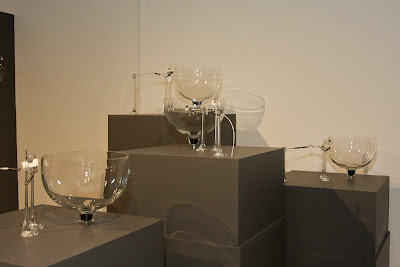Their piece is based on the idea of the singing wine glass—the amazing ability of glass vessels to produce sound when rubbed with a wet finger along their top edge. This phenomenon has fascinated people since at least the 16th century (and personally I’ve been fascinated by it since I discovered it for myself at a bar mitzvah at age 13), but it was never more popular than in the mid 1700s. At that time, Benjamin Franklin, the statesman and inventor, took it upon himself to make the singing wine glasses easier to play.
 |
| Benjamin Franklin’s glass armonica. Source: pbs.org. |
Using the same ingenuity and focus that brought the world electricity, bifocals and the urinary catheter, Franklin set about improving this curious instrument. First, he had glassblowers create 38 vessels of graduating sizes. Then, he nested them on a spindle that rotated by pressing peddles—much like those on a piano [image of armonica]. In fact, the whole instrument, which he called the glass armonica took the shape of a piano (an interesting side note on naming: Franklin said he named the instrument for the “musical country” of Italy because it seemed particularly well suited for “soft and plaintive” Italian music. Read it in his words here.
Players could sit in front of this instrument and place both hands on the rotating spindle of glasses before them. Whereas the horizontal layout of the singing wine glasses meant a player could only make two notes at a time, one with each hand, on the armonica, each finger could hit a separate note. The invention opened a world of possibilities and became an instant success. Mozart and Beethoven composed for the instrument and several well-to-do families purchased armonicas for home use.
 |
| Thomas Bloch plays his glass harmonica made by Gerhard Finkenbeiner. |
But the armonica’s fame was short lived. Just 20 years after its illustrious debut, there was widespread concern that the instrument’s ethereal notes had a serious negative effect on players’ moods, causing depression and neurological disorders. Though there were likely many reasons for this precipitous downfall, one of the most convincing (and certainly the most juicy) is that the armonica’s bad reputation came from its association with Franz Mesmer, the inventor of hypnotism and from whom we get the word “mesmerization.”
As legend has it, Mesmer would use the instrument to lull his patients (his work was considered more or less “medical”) into an entranced state where they could not be held responsible for their actions. This loss of decorum, so out of line with late-eighteenth-century social morays, caused the instrument to be seen as suspect.
Whether this was the main reason the armonica went out of fashion or not, within decades the instrument was hardly known and by the turn of the 20th century, it had all but disappeared, a lost footnote in the history books. That is, until Ethan and Andy unearthed it.
Ethan Rose and Andy Paiko were introduced by mutual friends while both were living in Portland, Oregon. Recognizing a shared interest in recovering and repurposing antiquated objects and technologies, Ethan and Andy worked to find a subject for a collaborative installation. On a camping trip, they visited the Spark Museum of Electrical Invention. It was there that they got the idea for this exhibition.
Using the armonica as their source, Ethan and Andy have created an exquisite installation showcasing the possibilities of the material—specifically glass vessels--to create sound. By removing the player from the installation (glass mechanisms, like record arms with fabric tips, meet the surface to create sound), the artists have placed the attention on the objects themselves; they have created a perfect environment for contemplating the properties of glass, the capabilities of material, the processes of creating and hearing sound, and the legacies of history.
 |
| Installation view of Transference: Andy Paiko & Ethan Rose at Houston Center for Contermporary Craft Photo by Kim Coffman |
 |
| Installation view of Transference: Andy Paiko & Ethan Rose at Houston Center for Contermporary Craft Photo by Kim Coffman |
But don’t take my word for it—hear Andy Paiko and Ethan Rose speak about the piece themselves in these incredible videos below. And come on in to see the show—it’s up until May 13, and it’s worth seeing multiple times.
-- Susie Silbert, HCCC Curatorial Fellow

I discovered your blog site on Google and check a few of your early posts. Continue to keep up the very good operate. I just additional up your RSS feed to my MSN News Reader. Seeking forward to reading more from you later on!…Glasses
ReplyDelete